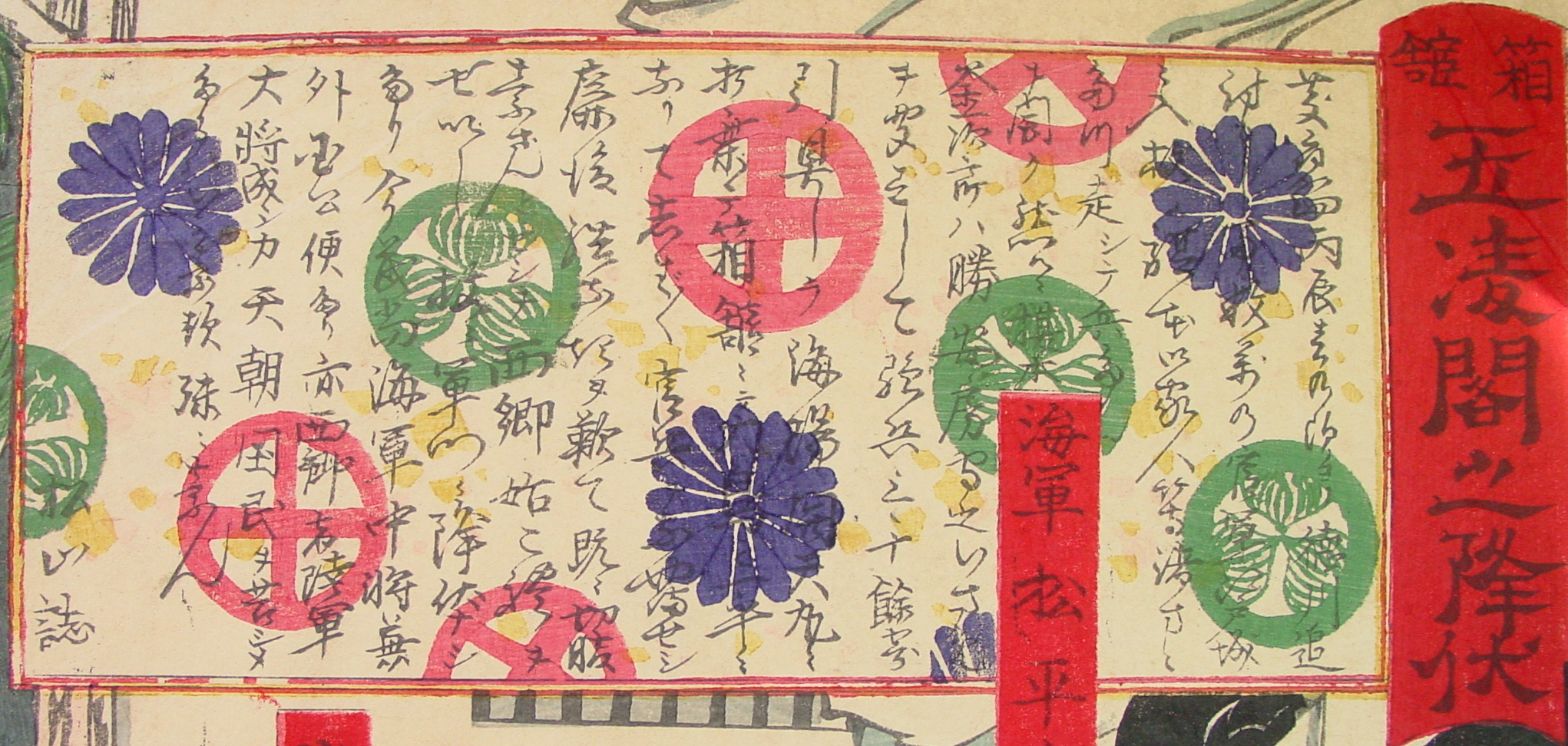About This Print
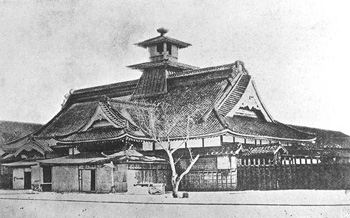 | This print is one of a number of "redemption" prints created during and immediately after Saigō Takamori's failed 1877 Satsuma Rebellion against the Meiji government. These prints sought to redeem Saigō by portraying his earlier exploits fighting to overthrow the Tokugawa shogunate and his subsequent defense of the Meiji government against continuing insurrection by rebellious samurai. This print depicts the June 1869 surrender of the Ezo rebels at Goryōkaku, the "star fort" in Hakodate in southern Hokkaidō. The Ezo rebels were loyalists to the defeated shogunate and the last significant military threat to the Meiji imperial forces. In this scene Saigō Takamori1 (central figure in the center panel) is demanding (or, perhaps, accepting) the |
Placing Saigō at the scene of the surrender is taking historical license as Saigō did not reach the rebels stronghold until after the surrender was made3 to Kuroda Kiyotaka 黑田 清隆, who is not shown in the print.
In addition to Saigō and Enomoto, other figures represented are Matsudaira Tarō 海軍 松平太郎, vice president of the Ezo Republic (right panel, figure in green robe); Hijikata Toshizō 土方 歳 三, vice minister of the Ezo army4, (right panel, seated behind Matsudaira, and partially hidden from view); Kasuga? Zaemon 春日 左衛門, a captain in the Ezo army (right panel, seated far right in blue-gray shirt); Ootori Keisuke 大鳥圭介 Tokugawa retainer and commander-in-chief Ezo Republic (right panel into center panel, seated and leaning towards Enomoto); Beppu Shinsuke 別府 府助, an officer in the Imperial army and a loyal follower of Saigō (center panel, seated to the left of Saigō); and Arai Chokunoshin? 浅井 直之進, a follower of Saigō (left panel kneeling). The remaining Saigō supporters in the left panel are currently unidentified, i.e. their names in the cartouches are not translated. The red wigs seen in the left panel identify their wearers as imperial soldiers of the Tosa Domain.
Pictured in the background are three ships at anchor in Hakadote Bay, including the Kaiyō Maru 海陽丸 one of Japan's first modern warships and part of the flotilla that Enomoto sailed to Hakodate, and the Kasuga Maru 春日丸, both part of the imperial Japanese navy.
1 The cartouche above his figure in the center panel identifies the figure as Saigō Kichinosuke 西郷 吉之助, one of the many names the leader of the 1877 Satsuma Rebellion adopted during his life.
2 Enomoto's name is preceded by the characters 徳川臣 indicating he his a "Tokugawa retainer." Enomoto was pardoned in 1872 and went on to be vice-admiral and then minister of the imperial navy.
3 The Last Samurai: The Life and Battles of Saigo Takamori, Mark Ravina, John Wiley & Sons, Inc., 2004, p. 163.
4 Placing Hijikata in this scene may be another historical inaccuracy as according to a Wikipedia entry http://en.wikipedia.org/wiki/Hijikata_Toshiz%C5%8D "on June 20 (lunar calendar May 11), 1869, Hijikata was killed while in combat on horseback by a bullet that shattered his lower back."
The Ezo Republic
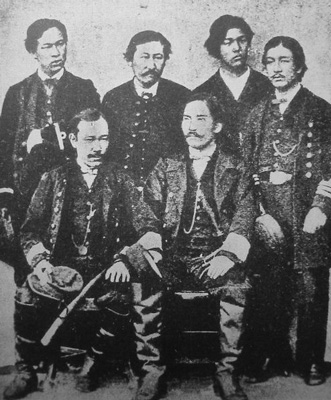 Leaders of the Ezo Republic including Enomoto Takeaki, bottom right.(wikipedia) | Source: Emperor of Japan: Meiji and His World, 1852-1912, Donald Keene, Columbia University Press, 2002, p. 155. The best-known revolt against the imperial government during the period after the surrender of Edo Castle by shogunate forces in March 1868 was undoubtedly the one staged by Enomoto Takeaki. Five months after Edo Castle was surrendered to the imperial army, Enomoto escaped with eight warships.... [H]e went on to Ezo (Hokkaidō), establishing himself at the modern Five Point Fortress [Goryōkaku] near Hakodate... On January 14, 1869, Enomoto sent a message to the court through the British and French ministers asking permission to develop the northern region. In a reply sent on January 26 to the two [British and French] ministers, Iwakura Tomomi [of the Meiji government] declared that Enomoto's words and actions did not match, that he would not be able to escape the name of traitor. This severe response may have occasioned Enomoto's declaration of the "Ezo republic," which won the conditional recognition of the British and French squadrons that happened to be in Hakodate. The attempt to create a country where supporters of the shogunate could live in the traditions of the shogunate ended in failure on June 27, 1869, when Enomoto surrendered to imperial forces led by Kuroda Kiyotaka... |
Scroll Detail
click on image to enlarge
Print Details
| IHL Catalog | #481 |
| Title or Description | Surrender of Goryōkaku 函館 五稜郭の降伏 |
| Artist | Hayakawa Shōzan (1850-1892) |
| Signature | 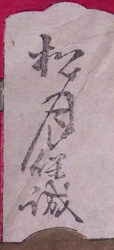 松月保誠 Shōgetsu Yasusei |
| Seal | not sealed |
| Publication Date |  |
| Publisher | 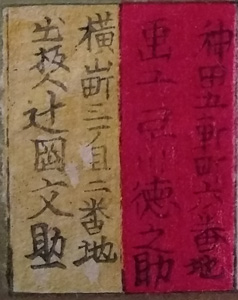 left half: 出板 辻岡文助 shuppanjin Tsujioka Bunsuke, preceded by address 横山町三丁目二番地 right half: 画工 早川徳之助 artist Hayakawa Tokunosuke (birth name of artist), preceded by address 神田五軒丁六番地 Yokoyamachō Sanchōme 2-banchi [Marks: pub. ref. 548; seal not shown] |
| Impression | good |
| Colors | excellent |
| Condition | fair– light wrinkling and folds throughout; worm damage lower left edge on left panel; full-size sheets untrimmed and not backed |
| Genre | ukiyo-e; senso-e |
| Miscellaneous | |
| Format | vertical oban triptych |
| H x W Paper | 14 1/2 x 9 1/4 in. (24.1 x 23.5 cm) each sheet |
| Literature | |
| Collections This Print |
8/5/2020
1/3/2019

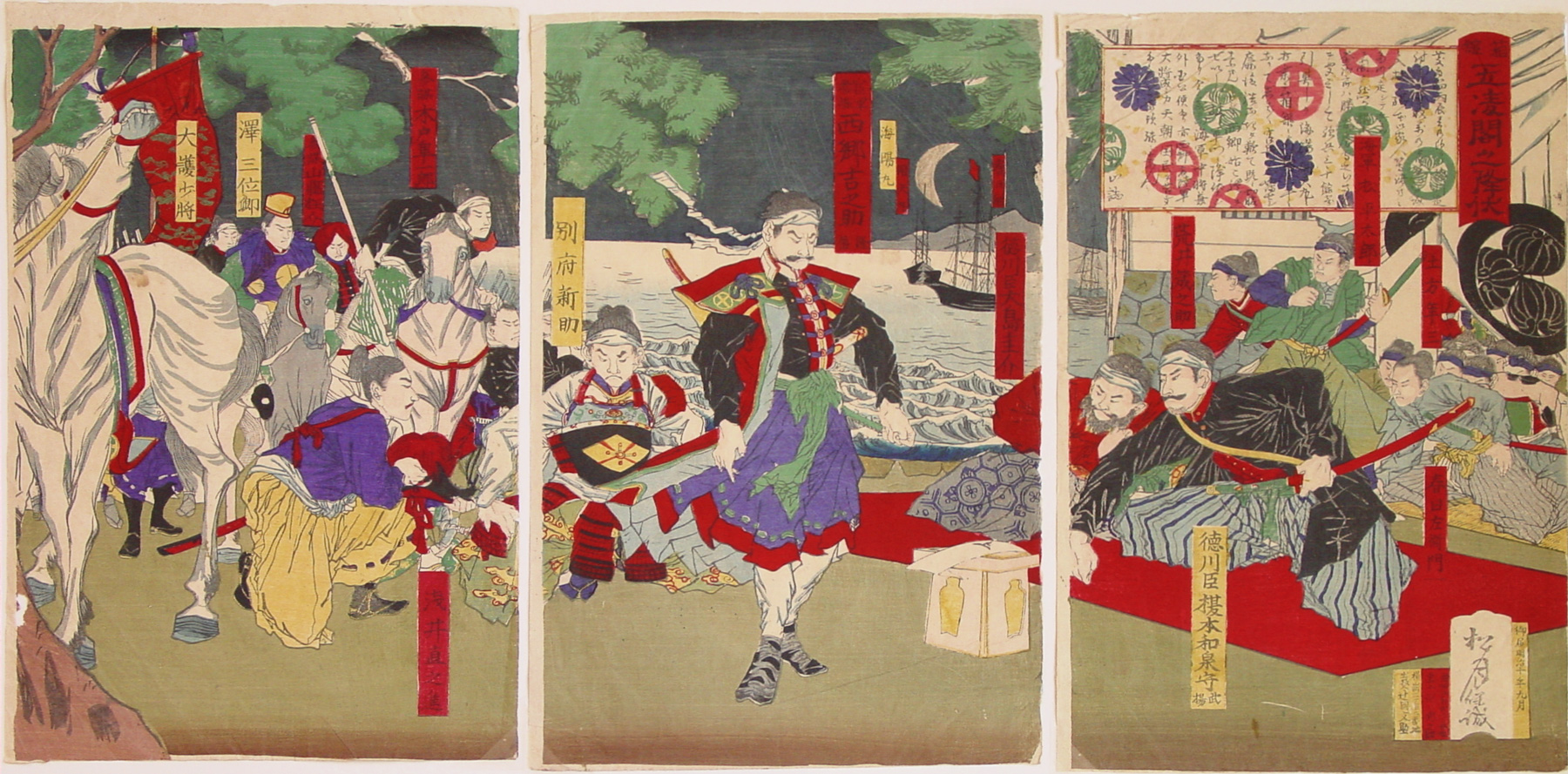
![Illustration of [Emperor at] National Diet Building](../hideo-hagiwara-1913---2007-/circus-no-7/Next-print-rev1-30x30.jpg)
